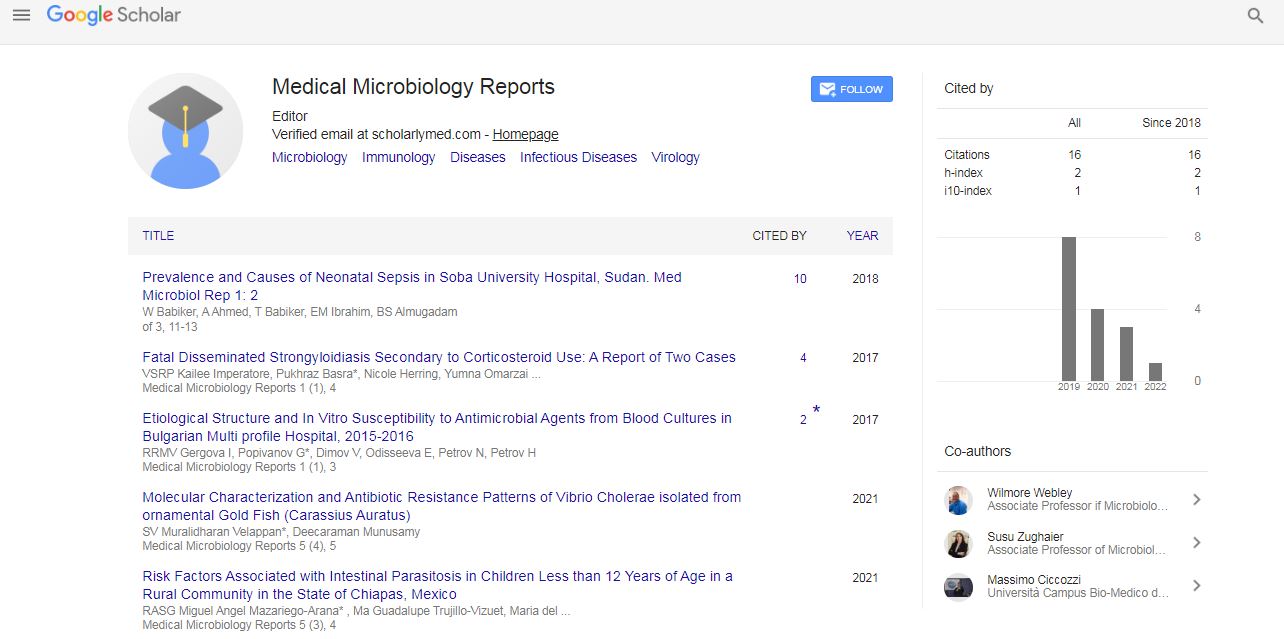Short Communication, Med Microbiol Rep Vol: 5 Issue: 1
Evaluation of antimicrobial and antioxidant activity of Zyziphus spina-cristi acetone extract against some Pathogenic microorganisms
Rasheed H. M. Al-Husami
Dept. of Food science & Technology, Faculty of Agriculture., Sana'a Univ., Yemen
Abstract
This Investigation was carried out in an attempt to study the antimicrobial activity of Zizyphus spina-cristi traditionally used in Yemen against some pathogenic microorganisms including Staphylococcus aureus (ATCC653-8), Pseudomonas aeruginosaMTCC2453 Mar.2001, Bacillus cereus (ATCC6633), Escherichia coli MTCC739 Mar.2001, Candida albicans(ATCC2019) & Staphylococcus epidermides(local isolate). The results indicated that the Ziziphus spina-crista acetone extract is affective against tested gram positive bacteria while don’t have any effect against tested gram negative bacteria in addition to Candida albicans. In general, all extracts given an effect on the gram positive bacteria only, The highest inhibition zone given by the high concentration of Ziziphus spina-cristi acetone extract 300mg/ml on Bacillus cereus. While the lower inhibition zone given by third concentration 100mg/ml against B.cereus. The results of the DPPH scavenging activity of acetone extract possess antioxidant activity at different concentrations with IC50 value equal to 172.077 ug / ml compared to the IC50 value of control sample (L-Ascorbic acid) that equal to 145.8838 ug / ml.
Keywords: Antimicrobial Activity, Medicinal plants, Food borne Pathogens, Pseudomonas aerogenosa and Staphylococcus aureus.
Abstract
This Investigation was carried out in an attempt to study the antimicrobial activity of Zizyphus spina-cristi traditionally used in Yemen against some pathogenic microorganisms including Staphylococcus aureus (ATCC653-8), Pseudomonas aeruginosaMTCC2453 Mar.2001, Bacillus cereus (ATCC6633), Escherichia coli MTCC739 Mar.2001, Candida albicans(ATCC2019) & Staphylococcus epidermides(local isolate). The results indicated that the Ziziphus spina-crista acetone extract is affective against tested gram positive bacteria while don’t have any effect against tested gram negative bacteria in addition to Candida albicans. In general, all extracts given an effect on the gram positive bacteria only, The highest inhibition zone given by the high concentration of Ziziphus spina-cristi acetone extract 300mg/ml on Bacillus cereus. While the lower inhibition zone given by third concentration 100mg/ml against B.cereus. The results of the DPPH scavenging activity of acetone extract possess antioxidant activity at different concentrations with IC50 value equal to 172.077 ug / ml compared to the IC50 value of control sample (L-Ascorbic acid) that equal to 145.8838 ug / ml.
Keywords
Antimicrobial Activity, Medicinal plants, Food borne Pathogens, Pseudomonas aerogenosa and Staphylococcus aureus.
Introduction
Plants are an excellent source of natural antioxidants and antimicrobials, which may act as a potential drug in modern biomedicine.(Voon et al., 2012). Since ancient times, medicinal plants have provoked interest as sources of natural products. They have been screened for their potential uses as alternatives remedies for the treatment of many infectious diseases the preservation of food. Plant products are rich sources of a variety of biologically active compounds, mainly phenolic, and these phytochemicals have been found to possess various biological properties like antioxidant and antimicrobial potentials (Kaneria et al., 2012).
The traditionally practices in Yemen and other societies, especially rural societies, medicinal plants and herbs have been used for many years to treatment of various diseases in animals and human beings (Al-Dubaie & Al-Khulaidi, 2005 & Tipu et al., 2006). There are many medicinal plants in Yemen used customarily to various purposes such as Acacia species, Aloe plant and Purging nut (Al-Dubaie & Al-Khulaidi, 2005).
Recently, many plants have been explored and reported for their ability to inhibit the growth of microorganisms, which can replace the chemically manufactured drugs (Ilic et al., 2004; Mandalari et al., 2007). Medicinal plants produce a variety of compounds such as phenolic, flavonoids, alkaloids, glycosides, saponins essential oils, mucilage’s and tannins in all of their parts (root, stem, bark, leaves, seeds) which possess a healing physiological effect in the treatment of various diseases of animals and humans (Adhikari et al.,2010).
Zizyphus Spina-Christi L has been reported to have activity against bacterial and fungal pathogens that are normally quite resistant to modern medications (Nazif, 2002). The leaves are applied locally to sores, and the roots are used to cure and prevent skin diseases (Adzu et al., 2001).The leaves are applied as poultices and are helpful in liver troubles, asthma and fever (Michel, 2002). A number of important wild edible fruits have been identified among them is Zizyphus Spina-Christi which has served as a source of food and medicine for thousands of years (Baytop, 1984; Gultekin, 2007). Ziziphus spina-christi has been used in folk medicine as a depurative, demulcent, anodyne, stomach-ache, for toothaches, emollient, astringents, antibacterial, antifungal and as a mouth wash (Moodi et al., 2016; Mohammed et al., 2012). Increased attention has been paid to the genus Zizyphus due to its significant medicinal uses for hypoglycemic, hypotensive, anti-inflammatory, antimicrobial, antioxidant, anti-tumor, liver protective and immune function improvement purposes.
Materials and Methods
Sample collection:
The useful plant leaves were collected from Bani Alhusam in Taiz-Yemen at September 2015 and identified according to instructions of the Ministry of tourism and environment, (2002) and Al-Dubaie & Al-Khulaidi, (2005).The collected plant material was dried in an open air protected from direct exposure to sun light. All dried plant samples were finely ground by using an electrical grinder to a fine powder and made ready for extraction.
Preparation of extract:
Powdered of Z. spina-christi leaves plant was macerated in ratio 1:10 in 80% acetone at room temperature for 48 hours with occasional shaking.
Then the resulting extract was filtered by using filter paper (Whatman No 1.5, whatman Ltd., England). The solvent extract was evaporated to dryness in oven at 45Cº to yield dry crude extract. The obtained crude extract was filled to amber tight closed bottle glass in refrigerator until uses.
Antimicrobial assay
Microorganisms used include:
Staphylococcus aureus (ATCC653-8), Pseudomonas aeruginosaMTCC2453 Mar.2001, Bacillus cereus (ATCC6633), Escherichia coli MTCC739 Mar.2001, Candida albicans(ATCC2019) & Staphylococcus epidermides(local isolate).
The bacterial strains were maintained on trypton soya gar medium (TSDA), and the fungal strains were maintained on Sabouraud dextrose agar (SDA) medium.
Antimicrobial and Antibiotic assays:
The Antimicrobial and Antibiotic assay was performed by using Agar Well Diffusion Method according to (USDA, 2007 and Mahesh & Satish, 2008).
Antimicrobial assay
Four different concentrations of each extract of selected plants (300, 200, 100 and 50 mg/ml) were dissolved in 10% dimethyl sulfoxide (DMSO) in Phosphate buffered saline to be used in antimicrobial activity test. Extract solutions were prepared just before carrying out the test. Antimicrobial activity of the extracts was determined by agar well diffusion method as described by (USDA, 2007 and Mahesh & Satish, 2008) on Tryptone soya Agar (TSA).
In each of these plates four wells were cut out by using a standard cork borer (8 mm). About 60μl of each extract was added into different wells (triplicate each concentration), DMSO was used as a negative control. A positive control antibiotic disc was placed in the other plate. All the plates were incubated for 24h at 37°C. After incubation bioactivity was evaluated by measuring the zone of inhibition. All the experiment was performed in triplicates.
Antibiotic assays:
The Antibiotic assay was performed by using antibiotic standard disc diffusion. The antibiotic standard disc was get from HiMedia & Oxoid Company.
Results and Discussions:
Antimicrobial Activity of acetone extract:
The test of antimicrobial activity of Zizyphus Spina-Christi acetone extract was conducted on five types of positive and negative bacterial strains of Gram stain, which were tested. Staphylococcus aureus (ATCC653-8) , Bacillus cereus ATCC6633, Staphylococcus epidermides(local isolate), Escherichia coli MTCC739 Mar.2001 and Pseudomonas aeruginosa MTCC2453 Mar.2001) in addition to Candida albicans (ATCC2019); Comparing with the effect of some standard antibiotics used (in pharmacy) which are Ceftazidin (CAZ30), Aztreonam (AT30), Norfloxacin (NOR5), Gentamycin (Gen10), Co-Trimoxazole (COT25), Vancomycin (VA30), Nystatin (100IU)) Against those tested microorganisms.
The results shown and appeared that the acetone extract of Zizyphus spina-cristi has antimicrobial activity against gram positive bacteria (S.aureus , S.epidermides & B.cereus) at high concentration this results agree with study Olajuyigbe & Afolayan,(2012), The degree of antimicrobial activity may be accounted for by the flavonoids synthesized by plants in response to microbial infection (Hernandez et al., 2000; Schinor et al., 2007) and the exclusive ability of acetone to extract most flavonoids and steroids more than other solvents (Eloff et al., 2008; Afolayan and Lewu, 2009). while the different concentration had no any effect against gram negative bacteria( E. coli & P. aeruginosa) as well as C.albicans, in contrast to Olajuyigbe & Afolayan,(2012) where the highest diameter of the inhibition zone is 13 mm at the highest concentration 300 mg/ml against B. cereus bacterium, and the lowest value of inhibition zone equal to 10.5 mm at a concentration of 100 mg/ml against B. cereus bacterium. in another side the B.cereus was more sensitive to acetone extract followed by S.aureus then S.epidermides. This difference in sensitivity between gram positive and negative bacteria maybe return to bacterial cell wall composition where the entry of antibiotics as well as other complex molecules such as plant extracts into gram-negative bacteria requires a pathway through the lipopolysaccharide outer membrane.
This pathway is provided by protein channels called porins. The ability of molecules to pass through these channels is influenced by their size, shape, and electrical charge. It has been demonstrated that porins serve as major entry gates for antibacterial compounds in these organisms. These membrane proteins were originally thought to be absolutely responsible for the inherently higher resistance of gram-negative bacteria to antibacterial. Decreased entry of antibiotic into the bacterial cell is not important in gram-positive bacteria because they lack a lipopolysaccharide outer membrane. Although the peptidoglycan layer of gram-positive bacteria is thicker than that of gram negative bacteria, it does not pose a significant barrier to antibiotic entry (O’Shea and Moser 2007).
 Spanish
Spanish  Chinese
Chinese  Russian
Russian  German
German  French
French  Japanese
Japanese  Portuguese
Portuguese  Hindi
Hindi 
